Dear Friends,
Thank you so much for your interest in the LYWA monthly eletter. Your interest and support mean a lot to us, and I’d be grateful if you would share our eletters with any who’d be interested.
I was really sorry not to be able to be in Singapore for Lama Zopa Rinpoche's March visit as I had planned, but as a result I was in Boston as His Holiness the Dalai Lama passed through on his way to Switzerland and got to hold his hand for twenty or so minutes during a small private audience arranged by Kurukulla Center’s Geshe Ngawang Tenley. Geshe-la was on his way to Singapore and His Holiness gave him a message for Rinpoche as well as personal advice. To the rest of us His Holiness stressed the importance of study as the basis of spiritual development and encouraged us to continue offering classes in Buddhist philosophy at the Center. His Holiness also stressed the importance of interfacing with other faiths and the science and psychology worlds.
New Video Series: Lama Zopa Rinpoche in Australia 2000
We have just posted a new series of video excerpts on YouTube which are drawn from Rinpoche’s previously unpublished teachings on the Heart Sutra, given in March, 2000 at Tara Institute in Melbourne, Australia. These excerpts cover topics such as the emptiness of the I and the importance of compassion, how we shouldn’t confuse space with emptiness, a great story about Lama Yeshe and commentary and oral transmissions of the Heart Sutra, the 35 Buddhas and the Vajrasattva mantra.
We have also posted the first transcript in the series that corresponds with two of these video excerpts. In this talk Rinpoche emphasizes how fortunate we are to be able to hear teachings on emptiness—even to hear one stanza or a few lines from the Buddha's teachings on the Perfection of Wisdom. Rinpoche also points out that just as the mind is beginningless, so too is ignorance. The only way to cease the suffering of samsara for ourselves and others is by realizing emptiness, which is the essence of the Heart Sutra.
SOCIAL MEDIA AND ONLINE JOURNALS
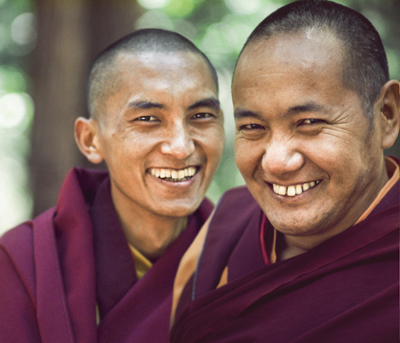 Last month our Facebook page hit a big milestone: 100,000 followers! We also rejoice in our 10,000+ followers on Twitter! Each day, our friends on social media are able to read gems from our online teachings, view amazing images, and keep up to date with our latest offerings, such as our "eFree" promotion, where each month we offer one of our ebooks as a free download. Don’t miss this month's eFree offering which is the first volume in Lama Zopa Rinpoche’s 1991 Teachings from Kopan series, Practicing the Unmistaken Path.
Last month our Facebook page hit a big milestone: 100,000 followers! We also rejoice in our 10,000+ followers on Twitter! Each day, our friends on social media are able to read gems from our online teachings, view amazing images, and keep up to date with our latest offerings, such as our "eFree" promotion, where each month we offer one of our ebooks as a free download. Don’t miss this month's eFree offering which is the first volume in Lama Zopa Rinpoche’s 1991 Teachings from Kopan series, Practicing the Unmistaken Path.
Lama Yeshe's and Lama Zopa Rinpoche's teachings have also been reaching more folks through our regular submissions to the widely-read online magazine, Elephant Journal. Each month we submit two or three excerpts from LYWA publications as short talks, with the latest being an excerpt from Lama Yeshe's Ego, Attachment and Liberation entitled Attachment: Grasping with Expectation. Elephant Journal has been a very effective vehicle for us to introduce the Lamas’ teachings to a brand new and enthusiatic audience.
New Advice from Lama Zopa Rinpoche
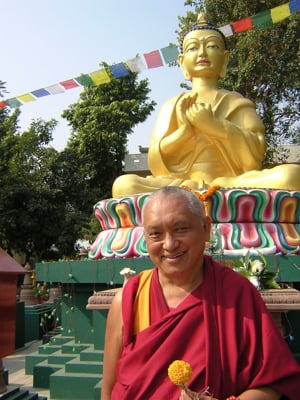 This month we have added a dozen new advices from Rinpoche to our Online Advice Book, including:
This month we have added a dozen new advices from Rinpoche to our Online Advice Book, including:
- Sunflowers for the Elderly: Rinpoche wrote to ask some students to send sunflower seeds to a home for the elderly at the Tibetan settlement in Hunsur, South India. He advised that the red flowers growing in the garden there were inauspicious.
- Amitabha is Guiding You: A student expressed his heartfelt devotion in a letter advising Rinpoche of his impending death. Rinpoche offered the following advice on how to think at this time.
- Chenrezig Meditation and Mantra: Rinpoche gave a photo of Chenrezig [Skt: Avalokiteshvara] to a waitress he met at a restaurant in Darjeeling, India. Later, he sent her this advice, which includes an explanation of the visualization, the numberless benefits of reciting OM MANI PADME HUM and how to dedicate the merits.
There are also two shorter posts which provide essential advice to reflect on: an email from Rinpoche with advice about impermanence to a long-time student, and advice to a student on how to live your life with bodhicitta in order to make it most beneficial for others, now and in the future.
As always, you can see a list of all new advices added to the website in the past month here.
Russian and Braille Translations
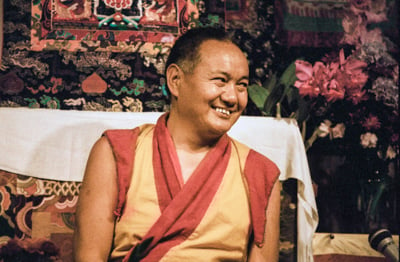 Our collection of LYWA teachings translated into Russian is steadily growing! We are pleased to announce the translation of Lama Yeshe's Ego, Attachment and Liberation. Translated by Anastasia Makarova and Anastasia Stoliarova.
Our collection of LYWA teachings translated into Russian is steadily growing! We are pleased to announce the translation of Lama Yeshe's Ego, Attachment and Liberation. Translated by Anastasia Makarova and Anastasia Stoliarova.
We have also added a collection of Russian translations of short talks by Lama Yeshe and Lama Zopa Rinpoche, also translated by Anastasia Makarova and Anastasia Stoliarova. Please see our Russian translation page for links to all these newly available translations.
We are also pleased to announce the conversion of Teachings from Tibet into Braille. Thanks to our incredible volunteer Alan Wilson, we now have 12 LYWA titles available to download in a format that is compatible with Braille embossers and displays.
LYWA Editors in Singapore
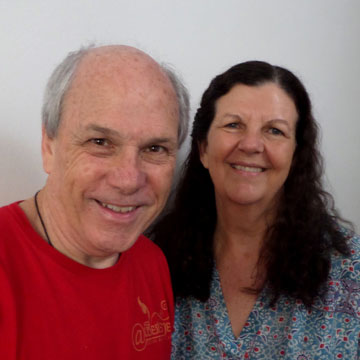 As I mentioned above, I was unable to attend Lama Zopa Rinpoche's Long Life Puja in Singapore, but was happy our wonderful Web Editor Sandra Smith was able to be there as LYWA's official representative. Fellow editors Ven Sarah Thresher and Gordon McDougall were in attendence as well. Sandy and Gordon were able to have an impromptu meeting while there to touch base about ongoing projects.
As I mentioned above, I was unable to attend Lama Zopa Rinpoche's Long Life Puja in Singapore, but was happy our wonderful Web Editor Sandra Smith was able to be there as LYWA's official representative. Fellow editors Ven Sarah Thresher and Gordon McDougall were in attendence as well. Sandy and Gordon were able to have an impromptu meeting while there to touch base about ongoing projects.
Sandy reported from Singapore: "Rinpoche made a special dedication during the Long-life Puja for books, both Wisdom and LYWA publications. He spoke about how books may be beneficial, even by seeing, touching, remembering or dreaming about them; no question by reading!" You can watch Rinpoche's remarks on this video at 5:21:44. Rinpoche said:
The books [published by the FPMT]—Wisdom books, Archive books—however they are spread in the world, may anybody who sees or touches them be most beneficial for sentient beings, and may all the sufferings of body and mind of anybody who simply sees, touches or remembers [these books], even in their dreams, so no question anybody who reads them, be pacified immediately and may they never, ever get reborn in the lower realms. Whichever book is read, may the reader not only understand the words but also be able to have realization of the meaning and achieve full enlightenment as quickly as possible. May all our books be beneficial in that way.
We are grateful to all of you who make it possible for us to bring these books into the world everywhere, for the benefit of all.
Much love.
Nick Ribush
Director
This Month's Teaching: We think we’re conscious but we’re not
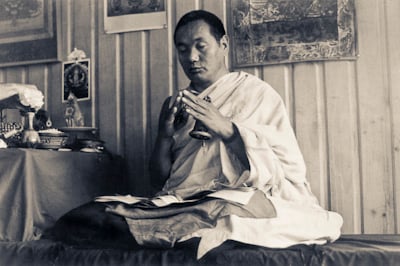 The nature of emotional pride is such that you go around with your nose in the air. You never want to see what’s in front of you or look down. The antidote is to do prostrations.
The nature of emotional pride is such that you go around with your nose in the air. You never want to see what’s in front of you or look down. The antidote is to do prostrations.
When I talk about prostrations I don’t mean that you prostrate to only the Buddha. As Shantideva said, we can also prostrate to all mother sentient beings by remembering that the basic, fundamental nature of their minds is as equally pure as that of an enlightened being.
Furthermore, doing prostrations doesn’t necessarily mean doing either the full-length or five-point ones. If you’re out on a busy city street and suddenly go down on the sidewalk people are going to freak out. Instead of doing that you can simply make mental prostrations. Remember, there are three ways of prostrating: with body, speech and mind.
The Buddha was so skillful. He gave us methods for every situation. So even if you’re on a crowded street and want to make prostrations, instead of putting on a big show and doing them physically, where everybody’s going to think, “What on earth is that?” you can just prostrate mentally.
If you do things with understanding, it’s so worthwhile. If you do them without understanding and then ask yourself, “Why am I doing this?” you’ll conclude that you’re going backwards instead of advancing. Practicing with understanding is helpful in treating your uncontrolled mind. If you practice like that everything will become worthwhile.
The same applies to making offerings. We don’t offer food to the Buddha because he’s hungry. We do it as part of training our mind to release emotional miserliness. The way we should look at charity is that no matter what the material value of what we give, the real value of generosity is in what we gain: knowledge-wisdom. Of course, it depends on your attitude. Even if you offer only one dollar you can still gain a lot. Basically you have to understand the psychology of the various Dharma practices you do, especially those that automatically make you uncomfortable.
But everything has meaning. For example, incense symbolizes the pure energy of body, speech and mind, especially pure thoughts. The real essence of incense is within you and the sticks we burn are external symbols of that. The real incense is in your mind. You have to know that, otherwise when you offer incense you’re just imitating people you’ve seen doing it, just copying Easterners. That’s not right. The real incense is your pure thought that gives pure vibrations to others.
It’s the same when you’re offering light. External lights have the function of destroying darkness, of making things clear. But the real candlelight is within you—it’s your wisdom. So whenever you offer incense or light you should do so with a dedication like, “May my mind and those of all mother sentient beings be filled with the light of knowledge wisdom and completely purified of the darkness shadow that makes us totally unconscious and causes all suffering.”
In other words, everything we do that might look like ritual is actually training our mind and freeing us from agitated states and impulses. It’s very useful.
Then why do we have all these physical objects on our altars? Buddhists are supposed to renounce material things and then we put all these statues and paintings here? That’s kind of strange. Well, we think it’s far preferable to having pictures of fashion models and rock stars on our walls. Those things automatically draw our attention and stimulate attachment. It’s like when we’re in the supermarket and see all these desirable foods and think, “Fantastic! How much money do I have? Oh, not enough, how can I get some?” and then we go, “Mom, Dad, can I have some money please?” “No, you can’t!” and we’re so disappointed.
That’s all visualization. Expert marketers know how to display products in order to trigger our attachment and make us want to buy them. They understand people’s basic psychological energy and how the combination of appealing object and craving desire reacts. That association makes us go pam! There’s contact and we go berserk. We lose wisdom and become unconscious.
We have to know this. We think we’re conscious but we’re not. When we’re overwhelmed by attraction and attachment we actually become unconscious. If you check carefully at such times you’ll find that perhaps at first your mind is very clear but as attachment takes over, something dark seems to envelop your mind. Check up. That’s experience. You see, Lord Buddha’s psychology is not about what you believe but what you experience. Go into town right now and see what happens! That’s reality.
And that’s why I always say that Lord Buddha’s teachings are so scientific. They’re very different from Western modes of religious expression. I’m not complaining. I’m just saying that Buddhist psychology and teachings may be different from what you were brought up with. They’re not about believing certain things and then going to heaven when you die; not about doing something now and waiting for a long time to experience the result. No! If you act correctly with wisdom right now you can see the result in the next second. It’s so simple.
Lama Yeshe gave this teaching at a weekend seminar in Christchurch, New Zealand, 14 June, 1975. Edited by Nicholas Ribush. Read the entire teaching here on our website.






























